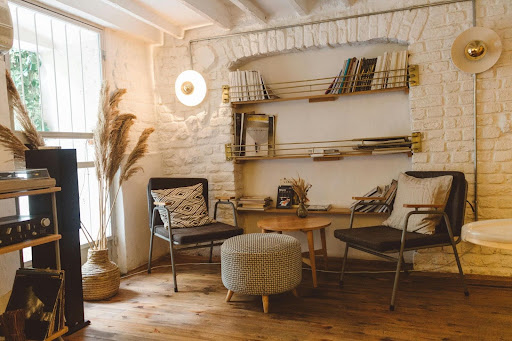Lifestyle
First Impressions Matter: Enhancing Your Home’s Appeal for House Showings

When it comes to selling your home, the adage “first impressions matter” is more than just a saying; it’s a critical factor in attracting potential buyers. A strong first impression can significantly influence a buyer’s decision-making process, often determining whether they feel an immediate connection to the home.
Photo by Emre Can Acer: https://www.pexels.com/photo/round-brown-wooden-table-between-two-chairs-and-ottoman-chair-2079246/
Enhancing your home’s appeal for showings not only increases the likelihood of selling faster but can also positively affect the sale price. Studies have shown that homes which excite buyers from the moment they step onto the property tend to fetch higher offers, making the initial presentation a key aspect of the real estate sales process.
The Power of Curb Appeal
Curb appeal is the attractiveness of a home’s exterior as viewed from the street, and it forms the buyer’s first impression even before they step inside. It sets the stage for expectations about the interior and can be a decisive factor in a buyer’s interest level.
A home with high curb appeal not only draws more attention but also sets a positive tone for the viewing. It suggests that the home is well-maintained and cared for, which can alleviate concerns about hidden maintenance issues.
Practical tips for boosting curb appeal:
Landscaping: Well-manicured lawns and pruned shrubs create a tidy and inviting look. Consider adding colorful flowers or new mulch to flower beds to brighten the exterior.
Painting: A fresh coat of paint on the front door, trim, and shutters can make a dramatic difference. Choose colors that complement the overall aesthetic of your home.
Cleaning: Power wash the siding, windows, and walkways to remove dirt and grime. Ensure gutters and roofs are clean and in good repair, as these are often overlooked yet critical elements of curb appeal.
Declutter and Depersonalize
Clutter can distract buyers from the true potential of your home. It makes spaces feel smaller and chaotic, which can deter buyers from envisioning themselves living there. A decluttered home appears larger, cleaner, and more appealing.
Start by removing any items that are not essential to the room’s function. This includes knickknacks, excessive personal photographs, and any bulky furniture that disrupts the flow of the space. Buyers will look inside closets and storage areas. Organized spaces suggest that the home has ample storage, a key selling point.
Benefits of Depersonalizing the Space
Depersonalizing involves removing personal artifacts like family photos, collections, and personalized decor. This helps buyers imagine their own lives and belongings in the space without the distraction of the current owner’s personal style and memories. It creates a neutral canvas that appeals to a broader audience, enhancing the home’s marketability.
Optimal Lighting
Lighting plays a crucial role in how buyers perceive your home during showings. Good lighting can make spaces appear bigger, brighter, and more inviting, whereas poor lighting can make even the most attractive rooms feel small, cramped, and uninviting. Effective lighting highlights the home’s best features and creates a warm, welcoming atmosphere. Choosing the best electric company Dallas can significantly impact your energy costs and service reliability. It’s essential to compare rates, customer reviews, and available plans to find the right provider for your needs.
Tips for enhancing home features with lighting:
Maximize Natural Light: Open all curtains and blinds to let in as much natural light as possible. Clean windows thoroughly to improve light entry.
Upgrade Artificial Lighting: Ensure that all rooms are well-lit by adding lamps or replacing dim light fixtures with brighter, modern options. Consider the color temperature of light bulbs; warm white bulbs can create a cozy feel, while cool white bulbs can brighten a room more effectively.
Accent Lighting: Use directed lamps or LED strips to highlight architectural features or artwork, adding depth and character to the rooms.
Repairs and Minor Upgrades
Addressing maintenance issues before putting your home on the market is vital. Buyers are often on the lookout for any signs that could indicate neglect or future costs, and visible maintenance issues can be significant red flags. Ensuring everything is in good working order reassures potential buyers that the property is well-cared for.
Suggested minor upgrades:
Fix Leaks and Squeaks: Repair leaky faucets, squeaky doors, and loose handles. These small fixes can make a big difference in the overall impression.
Update Hardware and Fixtures: Replacing outdated cabinet handles, doorknobs, and light fixtures can modernize a space without a significant investment.
Apply Fresh Paint: A fresh coat of neutral-colored paint can brighten up spaces and make them appear cleaner and more inviting.
Staging Strategies
Staging a home can significantly impact its appeal during showings. Professionally staged homes often sell faster and for higher prices because they look more appealing in photographs and in person. Staging helps highlight the property’s strengths and downplays its weaknesses.
Simple staging tips:
Furniture Placement: Arrange furniture to showcase the flow of the space. This might mean removing pieces to prevent rooms from feeling crowded.
Decorate in Neutrals: Neutral tones in decoration help buyers envision themselves in the space, making it easier for them to think about how they would use each room.
Accessorize Sparingly: A few well-placed accessories like vases, books, and cushions can add charm and character without cluttering the space.
By implementing these strategies—enhancing lighting, making minor repairs, and staging thoughtfully—you can significantly improve the attractiveness of your home for showings. Each element works together to create an inviting atmosphere that can lead to a successful and profitable home sale.
Creating an Inviting Atmosphere
Creating a welcoming environment is key during house showings. The atmosphere of a home significantly influences a buyer’s emotional response and overall impression. Here are some tips to ensure your home feels inviting:
Pleasant Aromas: Neutral, pleasant scents can make a home feel warm and inviting. Consider light fragrances like vanilla, lavender, or freshly baked cookies. Avoid strong or polarizing scents, as they can be off-putting to some buyers.
Comfortable Temperature: Ensure the home is at a comfortable temperature during showings. If it’s cold outside, a slightly warm interior is welcoming; if it’s hot, a cooler inside temperature will be refreshing.
Soft Background Music: Play soft, ambient music to help create a calming environment. Choose instrumental tracks as they are less likely to distract potential buyers.
Using Technology
In the digital age, integrating technology into home showings can greatly enhance how your property is presented.
Virtual Tours: Offer virtual tours to allow potential buyers to preview the home online before visiting in person. This can attract more serious buyers to physical showings.
High-Quality Photography: Invest in professional photography to capture high-quality images of your home. These photos should highlight the best features of the property and be used in online listings to generate interest.
Enhancing Physical Showings: Use technology to supplement physical showings—consider having a tablet on hand to show potential buyers before and after photos of any improvements, or to demonstrate the potential of unfinished spaces.
Conclusion
First impressions are crucial in the home selling process. Enhancing your home’s appeal through thoughtful preparation, strategic staging, and the smart use of technology can make a significant difference in how quickly your home sells and at what price.
By focusing on creating an inviting atmosphere, addressing any maintenance issues, and using every tool available to showcase your home’s best features, you improve your chances of attracting serious buyers and securing a successful sale.
Lifestyle
Everything You Need To Know About OhMyPretty Colored Wigs & Wear and Go Wigs

In later years, colored wigs and wear-and-go wigs have gotten to be progressively well known as a way for individuals to express themselves and alter up their see without committing to a changeless hair alter. Whether you’re looking to attempt out a striking modern color or basically need to switch up your fashion, colored wigs and wear-and-go wigs can be a fun and flexible alternative. In this article, we’ll investigate everything you require to know approximately colored wigs and wear-and-go wigs, from how to select the right wig to how to care for it properly.
What are Colored Wigs?
OhMyPretty colored wigs are wigs that come in an assortment of shades past conventional characteristic hair colors like dark, brown, and blonde. These wigs can be found in dynamic tints such as pink, blue, purple, and indeed rainbow colors. Colored wigs are an incredible way to try with distinctive looks without the commitment of forever coloring your hair. They can be a fun and lively way to express your identity and include a pop of color to your general style.
Choosing the Right Colored Wig
When choosing a colored wig, it’s imperative to consider your skin tone, eye color, and individual fashion. Warm-toned skin looks best with shades like ruddy, orange, and gold, whereas cool-toned skin complements colors like blue, purple, and silver. If you’re uncertain around which colors will suit you best, consider attempting on distinctive colored wigs or counseling with a proficient wig beautician for guidance.
What are Wear and Go Wigs?
OhMyPretty wear and go wigs, too known as ready-to-wear wigs, are wigs that come pre-styled and are planned to be worn straight out of the box. These wigs are helpful and simple to utilize, making them an incredible choice for tenderfoots or those who are brief on time. Wear and go wigs are accessible in an assortment of styles, lengths, and colors, so you can effortlessly discover one that suits your preferences.
How to Care for Colored Wigs and Wear and Go Wigs
Proper care is fundamental to keeping up the quality and lifespan of your colored wig or wear and go wig. Here are a few tips for caring for your wig:
- Capacity: When not in use, store your wig on a wig stand or in a breathable sack to anticipate tangling and keep it looking fresh.
- Washing: To clean your wig, tenderly wash it in cold water with a mellow cleanser and conditioner. Maintain a strategic distance from rubbing or bending the wig, as this can cause harm to the fibers.
- Styling: Utilize a wide-tooth comb or wig brush to fashion your wig, beginning at the closes and working your way up to the roots. Maintain a strategic distance from utilizing warm styling instruments on engineered wigs, as this can soften the fibers.
- Dodging Warm: If you have a manufactured colored wig, maintain a strategic distance from uncovering it to warm sources such as twisting irons or straighteners, as this can cause the filaments to liquefy or get damaged.
By taking after these care tips, you can guarantee that your colored wig or wear and go wig remains looking its best for as long as possible.
In Conclusion
Colored wigs and wear and go wigs are a fun and flexible way to alter your look and express your personal fashion. Whether you’re looking to attempt out a striking modern color or essentially need to switch up your haircut, colored wigs and wear and go wigs can be an extraordinary choice. By choosing the right wig, caring for it appropriately, and taking after these tips, you can appreciate your wig for numerous wears to come. So go ahead, grasp your inward fashionista and shake a colored wig or wear and go wig with certainty!
Lifestyle
Unveiling the Life of mary marquardt: A Journey Through Culinary Excellence

Mary marquardt is a name that resonates deeply within the culinary world. With a journey marked by passion, creativity, and dedication, she has carved out an impressive niche for herself. From her humble beginnings in the kitchen to becoming a celebrated chef, Mary’s story is one of resilience and innovation. Her love for cooking ignited at an early age, evolving into a lifelong commitment to excellence in gastronomy. Join us as we explore the vibrant life of Mary Marquardt—a tale rich with flavors and inspiration that every food enthusiast will appreciate.
Early life and passion for cooking
Mary Marquardt’s journey into the culinary world began in her childhood kitchen. Growing up, she was surrounded by the aromas of home-cooked meals. Her family valued food as a way to connect and celebrate.
Mary often found herself experimenting with ingredients, creating unique flavors from whatever was available. This early curiosity ignited a passion that would shape her future.
She spent countless hours watching her relatives cook, absorbing their techniques and love for gastronomy. Each dish they prepared told a story, captivating her imagination.
Those formative experiences laid the groundwork for Mary’s exceptional culinary skills. They instilled a deep appreciation for fresh produce and traditional methods that would define her cooking style later on. The joy of sharing meals with loved ones became one of her driving forces in this vibrant field.
Culinary education and training
Mary Marquardt’s culinary journey began with formal education. She enrolled in a prestigious culinary school, where her passion transformed into skill. The rigorous curriculum introduced her to classical techniques, kitchen management, and flavor profiles.
Hands-on training was vital during this period. Mary spent countless hours in the kitchen, honing her knife skills and mastering sauces. Each lesson added depth to her understanding of food.
Mentorship played a crucial role as well. Under renowned chefs, she absorbed invaluable insights about creativity and innovation. These experiences shaped not only her cooking style but also her approach to running a successful kitchen.
Her dedication didn’t stop at graduation; Mary continued to seek knowledge through workshops and culinary events. This relentless pursuit of excellence set the stage for what would become an illustrious career in gastronomy.
Career highlights and achievements
Mary Marquardt’s culinary career is marked by a series of remarkable achievements. She quickly made a name for herself in the competitive food industry, showcasing her innovative approach to traditional recipes.
One standout moment was her award-winning dish at the National Culinary Championship. This accomplishment solidified her status as a leading chef and opened doors to exciting opportunities.
Throughout her journey, she has collaborated with renowned chefs, enhancing her skills and broadening her culinary horizons. Each collaboration brought fresh ideas into her kitchen, allowing Mary to experiment boldly.
Her restaurant received numerous accolades, including several distinguished Michelin stars. This recognition highlights not only the quality of her cuisine but also her dedication to excellence in every aspect of dining.
In addition to running successful kitchens, Mary has authored best-selling cookbooks that have inspired countless home cooks around the world. Her passion for sharing knowledge reflects in every page written.
Signature dishes and cooking style
Mary Marquardt’s culinary style is a vibrant fusion of traditional techniques and modern flair. She emphasizes fresh, local ingredients that celebrate the seasons. Each dish reflects her commitment to quality.
Her signature dishes often showcase bold flavors and unexpected pairings. For instance, her lemon-thyme roasted chicken captivates with its zesty brightness. The crispy skin contrasts beautifully with tender meat.
Another standout is her heirloom tomato salad drizzled with balsamic reduction. It highlights summer’s bounty while allowing each ingredient to shine. This simplicity combined with depth defines her approach.
Mary also loves experimenting with spices, bringing a global influence to classic recipes. Her Moroccan spiced lamb shank has garnered rave reviews for its aromatic warmth and richness.
Every plate she creates tells a story rooted in heritage yet refreshed by innovation, making dining an unforgettable experience for all who savor it.
Influence on the culinary world
Mary Marquardt’s influence on the culinary world is profound and far-reaching. Her innovative approach to cooking has inspired countless chefs and home cooks alike.
Her ability to blend traditional techniques with modern flavors sets her apart. This fresh perspective encourages others to explore new dimensions in their own kitchens.
Moreover, Mary’s commitment to sustainability resonates deeply within the culinary community. She advocates for using local ingredients, promoting a farm-to-table philosophy that many now embrace.
Through workshops and mentorship programs, she shares her knowledge generously. Emerging chefs look up to her not just for recipes but for wisdom about navigating the industry.
Her cookbooks have become staples on many kitchen shelves. They are filled with practical advice and creative inspiration that empower readers.
Mary Marquardt continues to shape culinary trends today, proving that passion paired with skill can impact gastronomy in meaningful ways.
Conclusion:
Mary Marquardt’s journey reflects the heart and soul of culinary art. Her dedication to her craft shines through every dish she creates.
Her influence extends beyond just recipes; it inspires budding chefs everywhere. They see in her story a pathway filled with creativity, hard work, and passion.
Whether you’re an experienced cook or a curious novice, Mary’s techniques offer something for everyone. She encourages experimentation in the kitchen while respecting traditional methods.
As we explore more about food culture, figures like Mary remind us how vital personal stories are in shaping our culinary experiences. Each meal tells a tale, rich with flavors that carry memories from one generation to another.
FAQ’S
What inspired Mary Marquardt to become a chef?
Mary was inspired by family gatherings where food played a central role. Those moments ignited her passion for cooking at an early age.
Where did Mary receive her culinary training?
Mary trained at prestigious culinary schools where she honed her skills under renowned chefs.
What are some of Mary Marquardt’s most famous dishes?
Some of Mary’s signature dishes include exquisite pasta creations and artisanal desserts that showcase local ingredients.
Lifestyle
Make1m luxury cars: A Deep Dive into the Pinnacle of Automotive Excellence

When it comes to make1m luxury cars, few names command as much attention and admiration as Make1m. These exceptional vehicles represent the pinnacle of automotive excellence, blending cutting-edge technology with unparalleled craftsmanship. Imagine cruising in a car that not only turns heads but also offers an ultra-luxurious driving experience like no other.
Make1m luxury cars are more than just modes of transportation; they are symbols of status and artistry on wheels. Each model is meticulously designed for those who seek perfection in every detail. From their sleek lines to high-performance engines, these cars redefine what it means to drive in style.
Join us on this journey as we explore the fascinating world of Make1m luxury cars, delving into their history, features, manufacturing process, and what truly sets them apart from the rest. Buckle up—this ride promises to be extraordinary!
History and Evolution of Luxury Cars
Luxury cars have a storied past that dates back to the early 20th century. The dawn of the automobile era saw brands like Rolls-Royce and Mercedes-Benz redefine what it meant to drive in style. These manufacturers paved the way for opulence on four wheels.
As technology advanced, so did luxury vehicles. Innovations such as automatic transmissions and air conditioning became standard features. The focus shifted from mere performance to comfort and design.
The 1970s ushered in an age where personal expression began to matter more than ever. Exotic materials, bespoke options, and cutting-edge aesthetics dominated this period.
In recent decades, electric luxury cars emerged, blending sustainability with high-end appeal. Brands are now navigating both technological advancements and eco-consciousness in their designs.
Today’s luxury car market is not just about speed or power; it embodies a lifestyle choice reflecting individuality and sophistication.
The Features and Characteristics of Make1m Cars
Make1m luxury cars are synonymous with sophistication. Each model boasts a distinct design that captures attention instantly.
Inside, the craftsmanship is unparalleled. Fine leather and exquisite wood accents create an opulent atmosphere. Every detail, from stitching to ergonomics, speaks of luxury.
Performance is another hallmark of Make1m vehicles. Powerful engines deliver thrilling speed while ensuring a smooth ride. Advanced technology enhances driving dynamics and safety features.
Connectivity options abound in these high-end cars. State-of-the-art infotainment systems keep drivers engaged while premium sound systems provide crystal-clear audio.
Eco-conscious buyers will appreciate innovative hybrid models that marry luxury with sustainability without compromising performance or style.
Personalization options allow owners to tailor their vehicle to match individual tastes—from bespoke colors to custom interiors—ensuring exclusivity at every turn.
The Making of a Make1m Car: Inside the Manufacturing Process
Crafting a Make1m luxury car is an art form. Each model begins with meticulous design, where engineers and designers collaborate to create stunning aesthetics.
The manufacturing process is equally impressive. Advanced robotics work alongside skilled artisans, ensuring precision at every step. The bodywork is shaped from high-quality materials, emphasizing both strength and elegance.
Next comes the interior—where luxury meets technology. Hand-stitched leather seats contrast with cutting-edge infotainment systems that cater to modern demands.
Quality control plays a pivotal role throughout production. Every component undergoes rigorous testing before it reaches the showroom floor.
This blend of craftsmanship and innovation results in vehicles that are more than just cars; they embody sophistication and performance for discerning clients who demand nothing but the best.
The Price Tag: What Makes Make1m Cars So Expensive?
When it comes to make1m luxury cars, the price tag often raises eyebrows. But what drives these figures sky-high?
First and foremost is the craftsmanship involved. Each car is a masterpiece, meticulously designed and built by skilled artisans. This level of attention ensures that every detail is perfect.
Then there’s the technology under the hood. Make1m cars showcase cutting-edge innovations, from advanced engine systems to state-of-the-art infotainment features. Such technology doesn’t come cheap.
Materials play a significant role as well. Premium leathers, rare woods, and high-grade metals are standard in make1m models, which enhances both aesthetics and performance.
Limited production runs contribute to rarity; fewer units mean higher demand among collectors and enthusiasts alike. Each vehicle represents not just transportation but an investment in artful engineering.
These factors combined create a unique product that commands its luxurious price point in today’s automotive landscape.
The Exclusivity Factor: Owning a Make1m Car
Owning a Make1m luxury car is more than just possessing a vehicle; it’s about embracing an elite lifestyle. These cars are not merely modes of transportation, but symbols of status and exclusivity.
Each model boasts limited production numbers, making them rare commodities in the automotive world. This rarity enhances their allure, attracting collectors and enthusiasts alike.
Beyond the craftsmanship lies a community of like-minded individuals who appreciate the finer things in life. Driving a Make1m connects owners to exclusive events and gatherings that celebrate luxury and innovation.
The customization options available further elevate ownership into personal expression. Every detail can be tailored to reflect individual tastes, ensuring no two cars are identical.
In this realm of opulence, owning a Make1m transcends mere possession; it becomes part of one’s identity—a statement to the world about style, taste, and success.
Conclusion:
Owning a Make1m luxury car is more than just about transportation. It’s about making a statement, exuding elegance, and showcasing an appreciation for the finer things in life.
Each vehicle represents cutting-edge technology, craftsmanship, and design that transcends time. Every curve and contour speaks to a legacy of excellence forged through years of innovation.
The allure of these cars lies not only in their features but also in the unparalleled experience they offer. Imagine gliding down the road with unmatched comfort while turning heads at every corner.
For many enthusiasts, driving a Make1m isn’t merely an act; it’s an occasion filled with pride. The exclusivity associated with these vehicles adds another layer of prestige that few can attain.
FAQ’s
What defines a Make1m luxury car?
Make1m luxury cars stand out due to their unparalleled craftsmanship, advanced technology, and exclusive features. These vehicles often incorporate bespoke elements tailored specifically for each owner.
Why are Make1m cars so expensive?
The price tag on a Make1m vehicle reflects the meticulous attention to detail in design, top-tier materials used in manufacturing, and limited production runs that enhance exclusivity.
Where can I buy a Make1m luxury car?
Purchasing a Make1m car typically involves direct contact with authorized dealers or luxury car boutiques specializing in high-end automobiles. Many brands also offer customization options directly through their websites.
-

 GENERAL1 year ago
GENERAL1 year agoDiscovering the Artistic Brilliance of Derpixon: A Deep Dive into their Animation and Illustration
-

 Posts1 year ago
Posts1 year agoSiegel, Cooper & Co.
-

 Lifestyle1 year ago
Lifestyle1 year agoPurenudism.com: Unveiling the Beauty of Naturist Lifestyle
-

 Lifestyle1 year ago
Lifestyle1 year agoBaddieHub: Unleashing Confidence and Style in the Ultimate Gathering Spot for the Baddie Lifestyle
-

 HEALTH1 year ago
HEALTH1 year agoTransformative Health Solutions: Unveiling the Breakthroughs of 10x Health
-

 Entertainment1 year ago
Entertainment1 year agoGeekzilla Podcast: Navigating the World of Pop Culture, Gaming, and Tech
-

 Entertainment1 year ago
Entertainment1 year agoKhatrimaza Unveiled: Exploring Cinematic Marvels and Entertainment Extravaganza
-

 BUSINESS1 year ago
BUSINESS1 year agoUnlocking the Secrets to Jacqueline Tortorice Remarkable Career and Accomplishments
